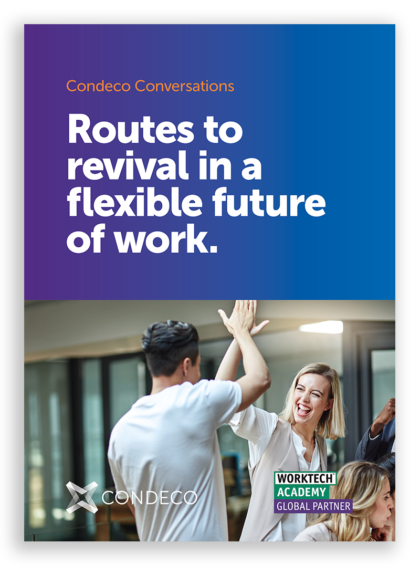Making flexible offices work will become a priority for organizations. As well-thought-out strategies turn into reality, organizations need to be armed with the right tools to curate a seamless and convenient experience for employees and a manageable workspace for their facilities management teams.
This requires a combination of control, allowing employees to optimize the workplace experience and feel a sense of control in doing so, and choice, giving people choice over where and how they work.
This means giving them the right spaces and tools on demand, and enabling them to find the right colleagues when they need them to get work done.
In this, our new eBook, Routes to Revival in a Flexible Future of Work, the final collaboration piece with our research partners WORKTECH Academy, we discuss:
- Learnings from workspace research
- What this means for the flexible office
- Priority for 2022 and beyond
Download your copy of Flexible Future of Work eBook
Condeco Conversations
Throughout our research program in conjunction with WORKTECH Academy, it presented the workplace as a multi-layered system in which formal knowledge-building activities (such as learning, mentoring and innovation) at the center are supplemented and bounded by more informal and casual collaboration and social activities. An outer ring of culture and well-being sets the tone for all that goes on inside the organization.
Looking back at the collective:
- eBook #1: Supporting Learning and Innovation
- eBook #2: Enhancing Experience and Collaboration
- eBook #3: Renewing Culture and Wellbeing
Now, organizations are planning their routes to revival and implementing flexible work policies that address these activities. As we move forward into 2022, the purpose of the office will be to support and enable employees in activities which are fundamentally more difficult outside the office. Organizations will be required to fuse technology, real estate and people policies to create a flexible office which works for everyone. However, the implementation of these strategies requires careful attention – one bad workplace experience will deter employees from returning to the office.
Many organizations have opted to adopt a hybrid model approach to work. This means employees will work across a spectrum of different work environments, and only come into the office if it benefits their work activities that day. One of the core benefits of this model is that employees have autonomy and choice over how and where they work best.
This approach means that the office can be used more meaningfully to accommodate the types of work that are better conducted in person. The research from 2021 paints a strong picture of what these types of activities are: informal collaboration, networking, socializing, learning and developing. Real estate teams are now tasked with the challenge of creating a seamless, simple and delightful experience for everyone who comes into the office.
Download a copy of your eBook here.
#CondecoConversations #CondecoInsights



